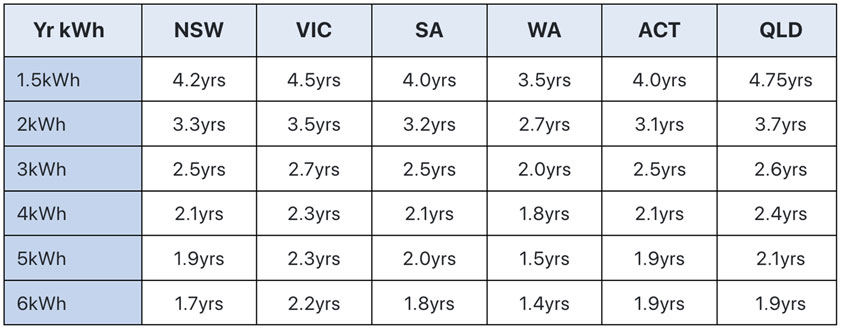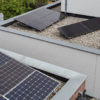Battery backups are hailed as the next big thing in solar technology, and for good reason. Since solar power is a way for us to reclaim our energy independence, a battery system will mean less reliance on a national grid.
Batteries are a tantalizing option for anyone looking to purchase a solar power system. On the one hand, batteries add a significant cost markup to any solar investment, which means it can take longer for the overall system to pay itself off.
And yet, because batteries allow you to save energy, you don’t have to purchase any electricity from the grid. Not to mention, with an energy backup on standby, you can sell power back to the grid at peak time, ensuring you get the most bang for your buck.
So, are batteries a worthwhile addition to your solar power system? Quick disclaimer, the scenario discussed below are simple illustrations and actual payback periods may vary greatly depending on a myriad of factors.
If you’re interested in finding out how solar+battery can help you, then we strongly recommend you get in touch with us for a more detailed breakdown.
How a Solar Payback Period is Calculated
Solar payback as a concept can be something of a debate, particularly because people have different interpretations of it. The most common misconception is that a solar power system pays itself off by selling excess electricity to the grid via Feed-In-Tariffs (FiTs), the receipts of which add up to cover the system’s upfront cost over time.
This assumption is not true and FiTs only accounts for a small percentage of a solar power system’s total payback potential. Current FiT rates vary between 5c and 12c per kWh in most of the states, but the cost of electricity sold to consumers is 25c to 40c per kWh on average.
As any electricity produced by solar panels is offsetting purchases from the grid, the bulk of a solar power system’s energy savings come from all the power you won’t have to buy. This is primarily why larger solar power systems pay themselves off quicker than smaller ones.
The formula for calculating a solar payback period is: Cost of the solar power system/savings per year because of the system.
Savings = kWh not purchased from the grid + earnings from FiTs.

How Batteries Add to the Payback Equation
Battery technology is still gaining traction, as such, it continues to command a substantial premium with standard prices being $1,000 per kWh. Adding any appreciative battery backup to your solar power system is therefore going to at least double your overall investment.
For example, let’s say you’re thinking of installing a 5 kWh solar power system which will retail for around $5,000 installed after solar rebate is applied. The system will produce around 20 kWh of electricity over a day (give or take), or 7,300 kWh per year. But, most of its output won’t be useful as it can’t be saved for evening and night times.
If you consume 50% of the system’s output, then 3,650 kWh can be exported to the grid. Assuming electricity rates in your area are 30c, and FiT is 10c, your system will save you $1,095 while helping you earn $365 every year, bringing your annual savings to $1,460. Provided your solar power system can sustain a 20 kWh/day output, it will take 3.4 years ($5,000/$1,460) to pay itself off.
So, how will the payback period look if we added a 5 kWh battery backup to your system? With a battery system, you can now use your panels to power your entire household the year round. Your yearly savings will jump to $2,190 (7,300 kWh X 30c).
However, since a 5 kWh battery system will go for around $5,000, your overall investment now stands at $10,000, which brings your payback period to 4.5 years ($10,000/$2,190).
Bear in mind that these numbers are based on the fact that your house consumes 7,300 kWh every year and that electricity retail rates and FiT remain fixed (which they in all likelihood won’t be).
If you need more, then you will need to purchase power from the grid, driving up your payback period. Conversely, if you can keep your footprint below 7,300 kWh, you may make a quicker return on your investment by availing FiTs.
Batteries allow you to sell electricity at peak prices, too. As power traffic jams increase, utilities often stop solar power systems from exporting electricity. Batteries can be very useful here as maximum stored energy can be sold when the lines are opened and/or at peak prices.
Should Batteries Be Included in Your Solar Plan?
The answer to the question in the headline is – it depends. In most cases, batteries will only increase the amount of time it takes as they will add quite a lot to the upfront purchase cost.
The viability of a battery backup therefore depends on your energy requirements, lifestyle and financial goals. In the example above, a one year increase in time to breakeven is certainly doable, but may increase or even decrease depending on several factors.
For instance, your system may not perform at the required rate, or something may break down, all of which will add weeks, months or even years to the payback period. Battery packs that go with solar backup systems have a lifespan of 5 to 15 years, much less than that of solar panels so, you will need to factor in a rather costly replacement in the foreseeable future.
On the flipside, battery prices are falling. Elon Musk has stated that the cost of Lithium batteries will be 56% less in 3-4 years time. Battery backups may even become a standard option in future solar power systems.
Batteries are coming under state-sponsored rebate programs as well. ACT is offering a rebate upto $3,500 per installation or 50% (whichever is lesser) to interested residents as per their Next Generation Renewables program. Similarly, Solar Victoria also has a $3,500 rebate on battery installations, provided solar power systems meet its criteria.
If we plug ACT’s rebate into the example above, then a 5 kWh battery backup will only cost $2,500, bringing the complete system’s price tag to $7,500. The time to breakeven is now 3.4 years ($7,500/$2,190), same as what it would take without a battery.
A Battery Backup May Be Right For You
Whether or not you should go for a battery backup will depend on a myriad of factors. For instance, if you live in ACT or Victoria, then you have a good chance of slashing a considerable amount off of a battery purchase. Similarly, if you live on an off-grid farm or homestead, then batteries may simply be non-optional.
As Australia’s premier solar energy search engine, we will be glad to help you figure out if a battery makes sense for your particular requirements or not. We have helped our clients save $3,100 on average on their installation and we will be happy to help you do the same. Feel free to contact us or call us at 1300-004-600 for a free consultation.





